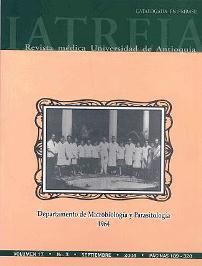Osmo osmolarity larity of lactic bever beverages ages ages, milks and inf infant ant formulas
DOI:
https://doi.org/10.17533/udea.iatreia.4063Keywords:
Diarrhea, Infantile diarrhea, Fluid therapy, Rehydration, Oral rehydration therapy, ProbioticsAbstract
Introduction: high osmolarity of the fluids administered during diarrhea can, in some cases, increase its volume. The use of fermented milk products for feeding children during diarrheal illness is frequently recommended. The objective of this study was to determine the osmolarity of some of these products, infant formulas and milks.
Materials and methods: the osmolarity of some kumis, yogurts, infantile formulas and milk, was determined.
Results: average osmolarity of 9 samples of industrial yogurts with fruits and sugar was 741 mOsm/L (SD 97.5); of 8 samples of light yogurts, 391 mOsm/L (SD 26.4); of 4 kumis samples with sugar, 658 mOsm/L (SD 69.9); of 3 samples of milk without lactose, 352 mOsm/L (DS 62.6); and of 4 samples of pasteurized milk, 262 mOsm/L (DS 6.3). Samples of infantile formulas and preparations based on pasteurized milk were also analyzed.
Discussion: in Colombia does not exist a culture of using fermented homemade lactic beverages. Commercial yogurts and kumis, with fruits and sugar, are available at relatively high cost and they have high osmolarity. It should be analyzed if their beneficial effects overcome the harmful ones produced by their high osmolarity.
Downloads
Downloads
Published
How to Cite
Issue
Section
License
Papers published in the journal are available for use under the Creative Commons license, specifically Attribution-NonCommercial-ShareAlike 4.0 International.
The papers must be unpublished and sent exclusively to the Journal Iatreia; the author uploading the contribution is required to submit two fully completed formats: article submission and authorship responsibility.














